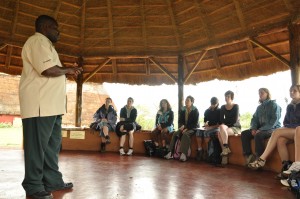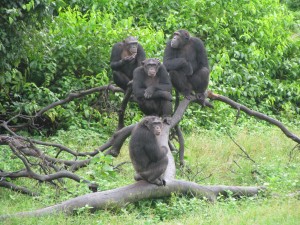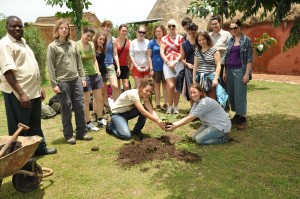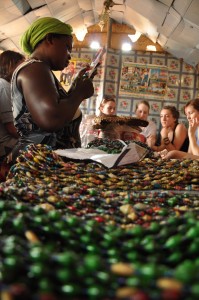Ngamba Island chimpanzees and beautiful beads
 Today we left our beds at 6.45 for an early breakfast and a ride on a boat which was going across Lake Victoria. Lake Victoria is the second largest freshwater lake in the world and it was a pleasure to be riding on it. Although it was raining and the water quite choppy, the volunteers managed to rest.
Today we left our beds at 6.45 for an early breakfast and a ride on a boat which was going across Lake Victoria. Lake Victoria is the second largest freshwater lake in the world and it was a pleasure to be riding on it. Although it was raining and the water quite choppy, the volunteers managed to rest.
Our boat trip was to Ngamba Island chimpanzee sanctuary, a 100 acre piece of land, which is home to 44 chimpanzees who have come from rescued background. 95% of the land is forested and the chimpanzees that live here are now a well formed group. Many of the chimpanzees will make their own nests in the forest, so do not need to spend as much time around humans as the others. Many more of the chimpanzees prefer to sleep in the holding cages which they are free to come into at night time, where they will also get to eat their food. This is also a place where they are able to monitor the chimpanzees.

Attached to the holding cages are cages which house chimpanzees who have had social problems or who are still being integrated slowly into the already formed group on the island.
Silver (our guide) spoke to us about the noises that the chimpanzees make and the pant hoots and excitable sound that they show when the food is arriving. This sounded alarming to many of the volunteers who thought this may sound like they chimps were fighting, so their minds were put at rest after Silver had explained this.
We were then given a tour of the offices and treatment rooms. The chimpanzees have full health checks once a year.
Every chimpanzee has its own record/diary which the handlers use often.
We were then taken to the viewing platform, which is on the edge of the forest. This is where the chimpanzees get fed. They get fed several times a day, but this particular feed is to allow visitors the chance to observe the chimpanzees on the outskirts of the forest. This was very interesting for us and we were able to look at the behaviour of some of the chimps, and could see how close to humans they were.
Stany (co founder of Ngamba island) spoke to the volunteers after the tour about the chimpanzees that were at the sanctuary and their emotions and behaviours that could be related back to children and humans. He focused on the rehabilitation of a chimpanzee from their difficult background which he then related to humans and their problems in integrating back into society.

The Yebo volunteers were then asked to plant a tree which is part of an educational program which is supported by Silver. We helped plant one tree which we named Yebo, we hope that this tree will grow strong and benefit the environment.
After our visit to this beautiful island we went onto another island, meeting the local people who make and sell jewelry. These are beautiful and hand made by the ladies at the island with paper and varnish. The volunteers were able to make their own bead, and also support the ladies by purchasing some of the beads and necklaces that had already been made. The ladies here were trained to make these beads in order to help them sustain a small wage for living.

We then played with some of the children on the island, and then stepped back on our boat and arrived back at UWEC.
The information and observations that we saw today should help us in our projects that we will be running with the children and the psychology side of things that we aim to acheive.
By Roger Mallins, April 5, 2010 @ 11:23 am
An excellent article,fully comprehensive explanation to us readers who have not experienced this brilliant primate environment.In conclusion The YEBO tree will be a permanent reminder to all concerned of the positive good you are all doing now and will do in the distant future.Keep going!!!!
By Silver, April 18, 2010 @ 5:17 pm
Thanks you all the Yebbo volunteers that visited Myende women group. Your visit meant soo much to these ladies. I’m just passing on this message on their behalf. They were very happy for your support. THANK YOU
Silver